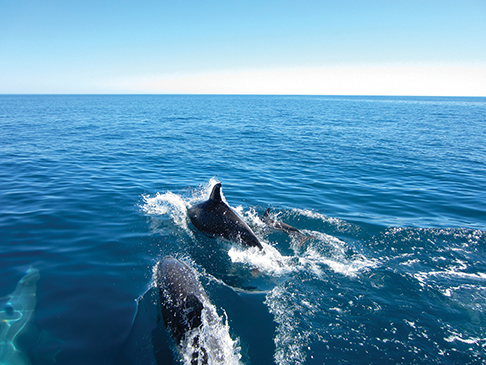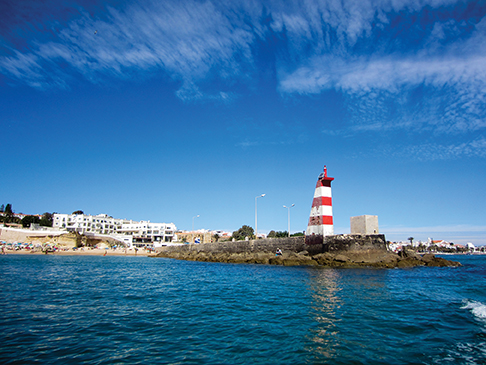Earning a prestigious RYA Yachtmaster certificate can take a sailor many years of courses and training. The author earned hers the Fast-Track way in 10 Demanding Weeks (published April 2018)
I didn’t know, but the five guys reviewing the basics of VHF communication in the cockpit of the yacht close-by were going to change my life by inspiring my biggest dream. I was there to complete my Royal Yachting Association (RYA) Day Skipper course and, by asking them what they were studying, I discovered they were “Zeros to Heroes”, RYA Yachtmaster Offshore Fast-Trackers aiming to get in 16-weeks all the experience and knowledge they needed to pass their final exam and get their Certificate of Competence. Since then, becoming a Yachtmaster was my dream.
But what is the RYA and what is a Yachtmaster? The RYA is the British national governing body for all forms of boating. Its training platform is recognized throughout the world (2,400 training centers, 600 of these outside the UK across 58 different countries) and every year over 165,000 recreational and professional sailors take RYA courses and exams.
For sailing, the RYA training programs cover windsurfing, dinghy and yacht cruising. And for cruising, the RYA interchanges theoretical and practical modules covering the entire spectrum of proficiency: Introduction to Yachting, Competent Crew, Day Skipper and Coastal Skipper. Moreover, the RYA releases three Certificates of Competence for the candidates who successfully pass the related exam: Yachtmaster Coastal, Yachtmaster Offshore and Yachtmaster Ocean.
 For each course and certificate, the RYA has a detailed syllabus, an educational program summarising all the theoretical and practical knowledge required to obtain each license. This guarantees the high-quality standard of all its training centers around the world, promotes the diffusion of standard procedures and builds up a shared culture among its students.
For each course and certificate, the RYA has a detailed syllabus, an educational program summarising all the theoretical and practical knowledge required to obtain each license. This guarantees the high-quality standard of all its training centers around the world, promotes the diffusion of standard procedures and builds up a shared culture among its students.
Between 2006 and 2014, I spent more than 70 days at sea sailing 2,200 offshore miles. But I felt the need to structure my practical knowledge, to get a framework to developing my sailing skills. Moreover, having moved from Italy to Ireland, I had two additional necessities: learn how to sail in tidal waters and get familiar with the sailing vocabulary in English.
For these reasons, in summer 2015 I decided to attend a nine-day RYA Day Skipper course in Gibraltar covering both the theoretical (four days in class) and practical aspects (five days onboard) of the related syllabus. Once at home, I also got from the RYA my ICC (International Certificate of Competence for Operators of Pleasure Craft ) to provide evidence of competence even in foreign countries.
During winter 2016, thanks to the knowledge previously acquired in class, I felt ready to take an online course to get my Coastal Skipper / Yachtmaster Offshore theory certificate. And the following summer I was able to attend the Coastal Skipper practical course in Lagos, Portugal.
Enthusiastic about the experience and the results achieved, deeply in love with Portugal and literally crazy for sailing, in 2017 I got a six months of leave of absence from my job in Dublin as manager of a Telesales Team to focus on my dream: become a Yachtmaster.
 I got in touch with RUsailing, the RYA training center, where I’d already attended my Coastal Skipper course in 2016, and asked them to design for me a tailored 10-week, Fast-Track program.
I got in touch with RUsailing, the RYA training center, where I’d already attended my Coastal Skipper course in 2016, and asked them to design for me a tailored 10-week, Fast-Track program.
So, on a rainy Saturday at the beginning of June, I took a low-cost flight to Faro, a dusty train for Lagos and, finally, I started my adventure.
My goal: get in 10 weeks the Yachtmaster Offshore Certificate of Competence, a certificate that would enable me to skipper vessels less than 200 gross tonnages up to 150 miles from a safe haven.
My plan: live onboard for the following 10 weeks, joining every week a different crew while working on my own long-term goal. Every day, five days a week, I committed to at least eight hours of sailing practice and two hours of study in the evening. On the weekend I focused on my studies (meteorology, signals, International Regulations for Preventing Collisions at Sea, etc.) and in gaining extra experience by shadowing my instructor while completing required fixes or maintenance activities on the yachts. A full-time and full-immersion Fast-Track, indeed.
Nobody else was sharing such a long stay. I’ve met more than 40 sailors attending Competent Crew, Day Skipper and Coastal Skipper courses during my 10 weeks in Portugal and this gave me an opportunity to learn how to sail with people with different personalities and various level of experience. But both my instructor and I had to put a considerable effort in place to guarantee, week after week, the seamless progress of my training.
 I also had a chance to practice on two completely different types of yachts: Firefly, an electrifying racing X-35, and Annecy, an elegant and comfortable Jeanneau Sun Odyssey 37. So, I experienced a diversity in people and boats while enjoying the always perfect sailing conditions provided by the Algarve. This area, in fact, is a real paradise for sailors (every day 20 knots of wind, flat sea and fresh and warm sun). Also, for all sea-lovers, there are dolphins playing at the bow, tunas jumping out of the water, flying fish appearing from nowhere. And, what can I say about the luminescent blue of the water, the bright orange of the perpendicular cliffs and the green hills filling the background of this beautiful landscape?
I also had a chance to practice on two completely different types of yachts: Firefly, an electrifying racing X-35, and Annecy, an elegant and comfortable Jeanneau Sun Odyssey 37. So, I experienced a diversity in people and boats while enjoying the always perfect sailing conditions provided by the Algarve. This area, in fact, is a real paradise for sailors (every day 20 knots of wind, flat sea and fresh and warm sun). Also, for all sea-lovers, there are dolphins playing at the bow, tunas jumping out of the water, flying fish appearing from nowhere. And, what can I say about the luminescent blue of the water, the bright orange of the perpendicular cliffs and the green hills filling the background of this beautiful landscape?
In this magnificent scenario, I started my training. My first week was a review week. I spent it with two students doing their Competent Crew course so I could cover every day most of the skipper’s tasks by myself.
The second week was similar in structure but, being more confident after my warm-up week, I was able to direct the crew much more and take charge of the yacht in most situations (berthing, anchoring, sailing in a confined space, etc.).
The third week I got some shore-based courses: Marine Radio Short Range, First Aid, Diesel Engine, Sail Maintenance and also a one-day review of my Coastal Skipper/Yachtmaster Offshore Theory in class.
The following week, the fourth, was essential. I crewed for two other students doing their RYA Yachtmaster Exam Preparation Course being able not only to observe their preparation but also to shadow their final assessment. It was an awareness week. For five days I saw them struggling with the multiple drills and exercises and, one day before the evaluation, I saw one of them withdraw from the exam because he was not feeling 100 percent ready.
I ended up being worried about my training and concerned about any gaps in my knowledge. Utterly absent-minded, I also had my first small injury: a broken middle finger on my left hand. But a tough week was the best thing that could happen to me at that stage; it re-boosted my focus, made me fully aware of how serious was the exam and gave me a chance to identify all the gaps I needed to fill in the following six weeks.
But my internal batteries were completely drained by the intense week, and I was so glad that the following week I had a break from my official preparation to do something different: race Firefly in the Regata dos Portos dos Descobrimentos, from Palos de la Frontera to Lagos. The race, commemorating the great explorers, was also the opportunity for me to get my first over 60-mile passage acting as a skipper on the delivery from Lagos to Palos de la Frontera.
Clearly, I had my problems. I underestimated a tidal flow so I had to extend my voyage almost 10 miles to bring the boat to a safe haven for the night. I also experienced my first broach while at the helm during a spinnaker drop. But, despite the challenges, it was a thrilling and refreshing week, and I really enjoyed our 24 hours upwind sailing, the constant attention to all the details, the continuous sail trimming, and even the long hours spent on the rail. I felt such a deep connection between us and the boat; we completely relied on each other to be able to fly on the waves.
 In my sixth week, I achieved my second over 60-mile passage acting as a skipper while experiencing a bit of ocean. We went up from Lagos to Sines, a beautiful small town mid-way between the Algarve and Lisbon. I was glad to have another chance to plan a long passage and happy that this time I did much better taking into account all the harsh lessons learned in the previous week. Moreover, being my first oceanic sailing experience, I experienced for the first time the long oceanic waves and the use of a watch system.
In my sixth week, I achieved my second over 60-mile passage acting as a skipper while experiencing a bit of ocean. We went up from Lagos to Sines, a beautiful small town mid-way between the Algarve and Lisbon. I was glad to have another chance to plan a long passage and happy that this time I did much better taking into account all the harsh lessons learned in the previous week. Moreover, being my first oceanic sailing experience, I experienced for the first time the long oceanic waves and the use of a watch system.
Week seven was much more about maneuvers such as man overboard, anchoring and mooring under motor and sail, berthing and unberthing in any situation. It was time for me to nail all my knowledge in these areas before moving on to the next stage of my preparation. To get a functional diversity in my practice, we sailed to all the marinas in Algarve (Portimao, Albufeira, Vilamoura) to practice in different conditions and situations.
During week eight, my training was focused on safety. I learned how to deliver not only the initial safety briefing but also how to brief the crew on advanced safety topics like flares and other distress signaling, fire prevention and fighting, life rafts and rescue procedures (including helicopter rescues).
Week nine was all about piloting. We went close to Faro, in the Ria Formosa Natural Park. This protected area is one of the most amazing places of the Algarve, a unique coastal lagoon that is protected from the sea by five barrier-islands and two peninsulas and which is continually changing due to the continuous movement of winds, currents and tides.
We spent almost two full days sailing in this lagoon, handling the boat under sail in such a confined area. We practiced all the piloting techniques (soundings, transits, clearing bearings, etc.) at day and night using all the buoys and visual aids, and calculating tidal heights and tidal streams for every single hour of our practice.
At the end of the ninth week, I was ready: all the Yachtmaster Offshore exam pre-requisites, in fact, were met: Radio Operator Qualification (min GMDSS Short Range Certificate); First Aid Certificate; 50 days / 2,500 miles (50-percnt conducted in tidal waters) of sea time, including at least five passages over 60 miles, acting as skipper for at least two of them and including two which have involved some overnight hours; Five days experience as skipper.
Finally, during the tenth week, I had my official RYA Yachtmaster Exam Preparation
Course. The week was intended to review the entire Yachtmaster Offshore Exam Syllabus:
• International Regulations for Preventing Collisions at Sea
• Safety
• Boat Handling
• General seamanship, including maintenance
• Responsibilities of the Skipper
• Navigation
• Meteorology
• Signals
 Clearly, with such a vast syllabus to cover, the week was dedicated only to briefly review all the topics and techniques included in the syllabus and the candidates have to be already proficient in all of them when they start their Exam Preparation Course.
Clearly, with such a vast syllabus to cover, the week was dedicated only to briefly review all the topics and techniques included in the syllabus and the candidates have to be already proficient in all of them when they start their Exam Preparation Course.
Although it was just a review, and because of the tension and the stress generated by the continuous drills, for me it was the worst week of my entire Fast-Track. I was so tense that I failed in exercises I had not failed, not even once, in the previous five weeks. It was a vicious circle. Every error made me lose a bit of confidence, and with less confidence, I made more and more mistakes. It was an awful week. I was emotional, I was worried and for the first time in my life, I was not enjoying sailing. I didn’t feel any joy while at the helm and I didn’t feel any connection with the boat.
So, in this unreal atmosphere, I got to my exam day. And the unexpected happened. On the exam day, in fact, everything was different. I was in control, I was confident, and I was enjoying every single moment.
I was one of two candidates, so we were expecting the exam to last up to 18 hours. We started at 10 in the morning preparing the boat to go to sea, delivering our safety briefing to the crew and completing our daily diesel engine routine checks (with few questions on engine maintenance and troubleshooting).
Then we were asked to complete some practical exercises in the marina: berth and unberth alongside, spring off, prop kick usage, yacht full-turn using ropes. After we had our first oral test covering IRPCS, general rules, steering and sailing rules, lights and shapes, sound and light signals and distress signals.
After a quick lunch that demonstrated our victualling abilities, we left Lagos to go to Portimao. During the following eight hours, we were asked to:
• Complete a man overboard recovery and, as a sailing exercise, a piece of equipment recovery going through two jibes and one tack before picking up
• Sail the boat to a given point (lat and long) and anchor there under sail
• Fix our position
• Complete blind navigation exercises both under power and under sail calculating our course to steer, giving sailing instructions to the crew while down below at the chart table and receiving from them speed, bearing and depth to re-estimate our position.
 After three months of dreaming about the perfect MOB manoeuvre during the exam, I completed a perfect one. For my blind navigation, the examiner asked me to sail all the way to Lagos (six miles upwind) and stop the yacht in front of the marina entrance. My strategy was to follow the coast outline by changing tack every time we got to a depth contour on my chart. And, when the examiner invited me in the cockpit to have a look around, we were just in front of the marina entrance!
After three months of dreaming about the perfect MOB manoeuvre during the exam, I completed a perfect one. For my blind navigation, the examiner asked me to sail all the way to Lagos (six miles upwind) and stop the yacht in front of the marina entrance. My strategy was to follow the coast outline by changing tack every time we got to a depth contour on my chart. And, when the examiner invited me in the cockpit to have a look around, we were just in front of the marina entrance!
 At 20.00, back into our berth in the marina, the examiner asked us some questions about meteorology and assigned to us a navigation theory question to work out.
At 20.00, back into our berth in the marina, the examiner asked us some questions about meteorology and assigned to us a navigation theory question to work out.
It was almost 22.00 when I finished. On the pontoon, waiting for me, were my instructor Rob, his wife Jules and the rest of the crew. It took them less than two seconds to understand, by the bright light in my eyes, that I made it. I had just become a Yachtmaster!















